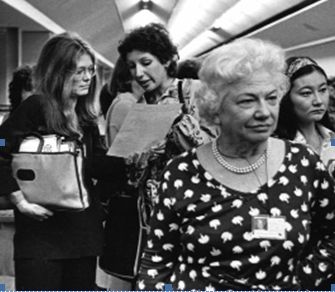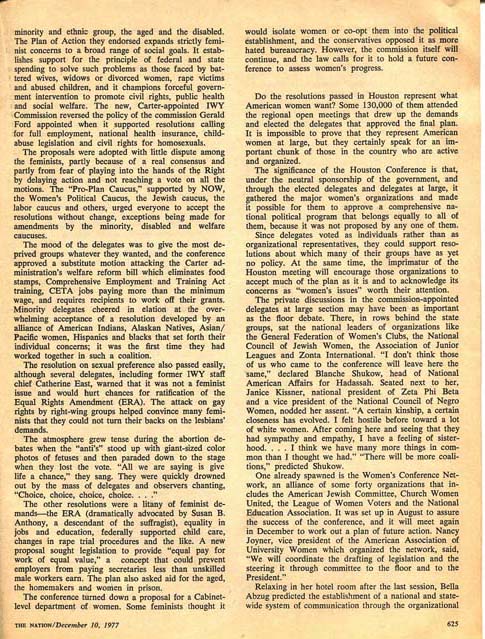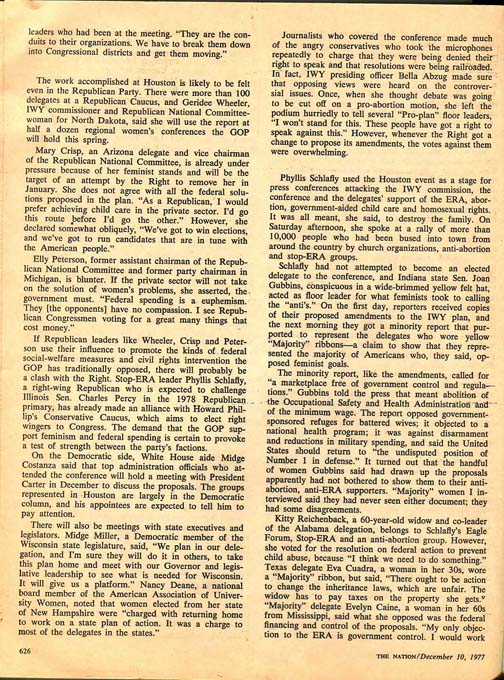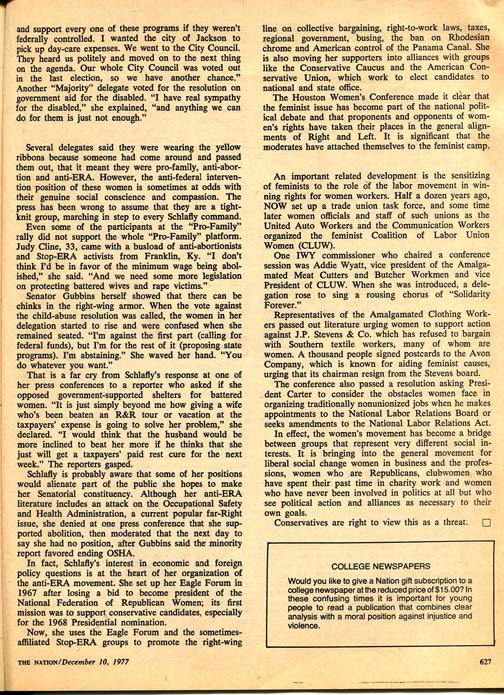
Lucy Komisar covered the women’s convention in Houston and wrote about it for The Nation, December 10, 1977. (text version is below)
WITH THE WOMEN AT HOUSTON: FEMINISM AS NATIONAL POLITICS
LUCY KOMISAR
The blue and green bunting, the state delegation signs, the three-cornered hats that said Free D.C., the scurry ing floor leaders, the midnight caucuses, the gaggle of reporters”there were all the signs of a political con vention at the Houston Women’s Conference. It was not a place for arcane discussions about the origins of patriarchy.
Delegates sat for hours on the Spartan folding chairs to approve a series of legislative recommendations that ranged from support of full employment to a call for national health insurance. Representatives of major national women’s groups said they would seek adoption of the program by their own boards and members. It marked the entry of a new force into the loose national coalition that works for civil rights, economic justice and social welfare in America.
The meeting was mandated by federal legislation intro duced by Bella Abzug in 1975 that called for a national gathering at which American women would recommend ways to remove the barriers to full equality for their sex. Preliminary conferences open to the public in the states and territories drafted resolutions and elected dele gates to Houston. The International Women’s Year (IWY) Commission, headed by Abzug, distilled the rec ommendations into a proposed National Plan of Action. Now, the conference report will be submitted to the President and the Congress. The law instructs Mr. Carter to send Congress his recommendations for action by July.
The 2,000 delegates, gathered in the Sam Houston Coliseum from the morning of November 19 to midday on the 21st, included some 300 members of the National Organization for Women (NOW), a larger number of conservatives, and a diverse collection of pro-feminist churchwomen, trade unionists, political activists and community leaders with careful representation of every minority and ethnic group, the aged and the disabled. The Plan of Action they endorsed expands strictly femi nist concerns to a broad range of social goals. It estab lishes support for the principle of federal and state spending to solve such problems as those faced by bat tered wives, widows or divorced women, rape victims and abused children, and it champions forceful govern ment intervention to promote civil rights, public health and social welfare. The new, Carter-appointed IWY Commission reversed the policy of the commission Gerald Ford appointed when it supported resolutions calling for full employment, national health insurance, child-abuse legislation and civil rights for homosexuals.
The proposals were adopted with little dispute among the feminists, partly because of a real consensus and partly from fear of playing into the hands of the Right by delaying action and not reaching a vote on all the motions. The Pro-Plan Caucus, supported by NOW, the Women’s Political Caucus, the Jewish caucus, the labor caucus and others, urged everyone to accept the resolutions without change, exceptions being made for amendments by the minority, disabled and welfare caucuses.
The mood of the delegates was to give the most de prived groups whatever they wanted, and the conference approved a substitute motion attacking the Carter ad ministration’s welfare reform bill which eliminates food stamps, Comprehensive Employment and Training Act training, CETA jobs paying more than the minimum wage, and requires recipients to work off their grants. Minority delegates cheered in elation at the over whelming acceptance of a resolution developed by an alliance of American Indians, Alaskan Natives, Asian/ Pacific women, Hispanics and blacks that set forth their individual concerns; it was the first time they had worked together in such a coalition.
The resolution on sexual preference also passed easily, although several delegates, including former IWY staff chief Catherine East, warned that it was not a feminist issue and would hurt chances for ratification of the Equal Rights Amendment (ERA). The attack on gay rights by right-wing groups helped convince many femi nists that they could not turn their backs on the lesbians’ demands.
The atmosphere grew tense during the abortion de bates when the anti’s stood up with giant-sized color photos of fetuses and then paraded down to the stage when they lost the vote. All we are saying is give life a chance, they sang. They were quickly drowned out by the mass of delegates and observers chanting, Choice, choice, choice, choice. . . .
The other resolutions were a litany of feminist de mands”the ERA (dramatically advocated by Susan B. Anthony, a descendant of the suffragist), equality in jobs and education, federally supported child care, changes in rape trial procedures and the like. A new proposal sought legislation to provide equal pay for work of equal value, a concept that could prevent employers from paying secretaries less than unskilled male workers earn. The plan also asked aid for the aged, the homemakers and women in prison.
The conference turned down a proposal for a Cabinet-level department of women. Some feminists thought it would isolate women or co-opt them into the political establishment, and the conservatives opposed it as more hated bureaucracy. However, the commission itself will continue, and the law calls for it to hold a future con ference to assess women’s progress.
Do the resolutions passed in Houston represent what American women want? Some 130,000 of them attended the regional open meetings that drew up the demands and elected the delegates that approved the final plan. It is impossible to prove that they represent American women at large, but they certainly speak for an im portant chunk of those in the country who are active and organized.
The significance of the Houston Conference is that, under the neutral sponsorship of the government, and through the elected delegates and delegates at large, it gathered the major women’s organizations and made it possible for them to approve a comprehensive na tional political program that belongs equally to all of them, because it was not proposed by any one of them.
Since delegates voted as individuals rather than as organizational representatives, they could support reso lutions about which many of their groups have as yet no policy. At the same time, the imprimatur of the Houston meeting will encourage those organizations to accept much of the plan as it is and to acknowledge its concerns as women’s issues worth their attention.
The private discussions in the commission-appointed delegates at large section may have been as important as the floor debate. There, in rows behind the state groups, sat the national leaders of organizations like the General Federation of Women’s Clubs, the National Council of Jewish Women, the Association of Junior Leagues and Zonta International. I don’t think those of us who came to the conference will leave here the same, declared Blanche Shukow, head of National American Affairs for Hadassah. Seated next to her, Janice Kissner, national president of Zeta Phi Beta and a vice president of the National Council of Negro Women, nodded her assent. A certain kinship, a certain closeness has evolved. I felt hostile before toward a lot of white women. After coming here and seeing that they had sympathy and empathy, I have a feeling of sister hood. . . . I think we have many more things in com mon than I thought we had. There will be more coali tions, predicted Shukow.
One already spawned is the Women’s Conference Net work, an alliance of some forty organizations that in cludes the American Jewish Committee, Church Women United, the League of Women Voters and the National Education Association. It was set up in August to assure the success of the conference, and it will meet again in December to work out a plan of future action. Nancy Joyner, vice president of the American Association of University Women which organized the network, said, We will coordinate the drafting of legislation and the steering it through committee to the floor and to the President.
Relaxing in her hotel room after the last session, Bella Abzug predicted the establishment of a national and state wide system of communication through the organizational leaders who had been at the meeting. They are the con duits to their organizations. We have to break them down into Congressional districts and get them moving.
The work accomplished at Houston is likely to be felt even in the Republican Party. There were more than 100 delegates at a Republican Caucus, and Geridee Wheeler, IWY commissioner and Republican National Committee woman for North Dakota, said she will use the report at half a dozen regional women’s conferences the GOP will hold this spring.
Mary Crisp, an Arizona delegate and vice chairman of the Republican National Committee, is already under pressure because of her feminist stands and will be the target of an attempt by the Right to remove her in January. She does not agree with all the federal solu tions proposed in the plan. As a Republican, I would prefer achieving child care in the private sector. I’d go this route before I’d go the other. However, she declared somewhat obliquely, We’ve got to win elections, and we’ve got to run candidates that are in tune with the American people.
Elly Peterson, former assistant chairman of the Repub lican National Committee and former party chairman in Michigan, is blunter. If the private sector will not take on the solution of women’s problems, she asserted, the government must. Federal spending is a euphemism. They [the opponents] have no compassion. I see Repub lican Congressmen voting for a great many things that cost money.
If Republican leaders like Wheeler, Crisp and Peter son use their influence to promote the kinds of federal social-welfare measures and civil rights intervention the GOP has traditionally opposed, there will probably be a clash with the Right. Stop-ERA leader Phyllis Schlafly, a right-wing Republican who is expected to challenge Illinois Sen. Charles Percy in the 1978 Republican, primary, has already made an alliance with Howard Phil-lip’s Conservative Caucus, which aims to elect right wingers to Congress. The demand that the GOP sup port feminism and federal spending is certain to provoke a test of strength between the party’s factions.
On the Democratic side, White House aide Midge Costanza said that top administration officials who at tended the conference will hold a meeting with President Carter in December to discuss the proposals. The groups represented in Houston are largely in the Democratic column, and his appointees are expected to tell him to pay attention.
There will also be meetings with state executives and legislators. Midge Miller, a Democratic member of the Wisconsin state legislature, said, We plan in our dele gation, and I’m sure they will do it in others, to take this plan home and meet with our Governor and legis lative leadership to see what is needed for Wisconsin. It will give us a platform. Nancy Deane, a national board member of the American Association of Univer sity Women, noted that women elected from her state of New Hampshire were charged with returning home to work on a state plan of action. It was a charge to most of the delegates in the states.
Journalists who covered the conference made much of the angry conservatives who took the microphones repeatedly to charge that they were being denied their right to speak and that resolutions were being railroaded. In fact, IWY presiding officer Bella Abzug made sure that opposing views were heard on the controver sial issues. Once, when she thought debate was going to be cut off on a pro-abortion motion, she left the podium hurriedly to tell several Pro-plan floor leaders, I won’t stand for this. These people have got a right to speak against this. However, whenever the Right got a change to propose its amendments, the votes against them were overwhelming.
Phyllis Schlafly used the Houston event as a stage for press conferences attacking the IWY commission, the conference and the delegates’ support of the ERA, abor tion, government-aided child care and homosexual rights. It was all meant, she said, to destroy the family. On Saturday afternoon, she spoke at a rally of more than 10,000 people who had been bused into town from around the country by church organizations, anti-abortion and stop-ERA groups.
Schlafly had not attempted to become an elected delegate to the conference, and Indiana state Sen. Joan Gubbins, conspicuous in a wide-brimmed yellow felt hat, acted as floor leader for what feminists took to calling the anti’s. On the first day, reporters received copies of their proposed amendments to the IWY plan, and the next morning they got a minority report that pur ported to represent the delegates who wore yellow Majority ribbons”a claim to show that they repre sented the majority of Americans who, they said, op posed feminist goals.
The minority report, like the amendments, called for a marketplace free of government control and regula tions. Gubbins told the press that meant abolition of – -the Occupational Safety and Health Administration and-of the minimum wage. The report opposed government-sponsored refuges for battered wives; it objected to a national health program; it was against disarmament and reductions in military spending, and said the United States should return to the undisputed position of Number 1 in defense. It turned out that the handful of women Gubbins said had drawn up the proposals apparently had not bothered to show them to their anti abortion, anti-ERA supporters. Majority women I in terviewed said they had never seen either document; they had some disagreements.
Kitty Reichenback, a 60-year-old widow and co-leader of the Alabama delegation, belongs to Schlafly’s Eagle Forum, Stop-ERA and an anti-abortion group. However, she voted for the resolution on federal action to prevent child abuse, because I think we need to do something. Texas delegate Eva Cuadra, a woman in her 30s, wore a Majority ribbon, but said, There ought to be action to change the inheritance laws, which are unfair. The widow has to pay taxes on the property she gets. Majority delegate Evelyn Caine, a woman in her 60s from Mississippi, said what she opposed was the federal financing and control of the proposals. My only objec tion to the ERA is government control. I would work and support every one of these programs if they weren’t federally controlled. I wanted the city of Jackson to pick up day-care expenses. We went to the City Council. They heard us politely and moved on to the next thing on the agenda. Our whole City Council was voted out in the last election, so we have another chance. Another Majority delegate voted for the resolution on government aid for the disabled. I have real sympathy for the disabled, she explained, and anything we can do for them is just not enough.
Several delegates said they were wearing the yellow ribbons because someone had come around and passed them out, that it meant they were pro-family, anti-abor tion and anti-ERA. However, the anti-federal interven tion position of these women is sometimes at odds with their genuine social conscience and compassion. The press has been wrong to assume that they are a tight -knit group, marching in step to every Schlafly command.
Even some of the participants at the Pro-Family rally did not support the whole Pro-Family platform. Judy Cline, 33, came with a busload of anti-abortionists and Stop-ERA activists from Franklin, Ky. I don’t think I’d be in favor of the minimum wage being abol ished, she said. And we need some more legislation on protecting battered wives and rape victims.
Senator Gubbins herself showed that there can be chinks in the right-wing armor. When the vote against the child-abuse resolution was called, the women in her delegation started to rise and were confused when she remained seated. I’m against the first part (calling for federal funds), but I’m for the rest of it (proposing state programs). I’m abstaining. She waved her hand. You do whatever you want.
That is a far cry from Schlafly’s response at one of her press conferences to a reporter who asked if she opposed government-supported shelters for battered women. It is just simply beyond me how giving a wife who’s been beaten an R&R tour or vacation at the taxpayers’ expense is going to solve her problem, she declared. I would think that the husband would be more inclined to beat her more if he thinks that she just will get a taxpayers’ paid rest cure for the next week. The reporters gasped.
Schlafly is probably aware that some of her positions would alienate part of the public she hopes to make her Senatorial constituency. Although her anti-ERA literature includes an attack on the Occupational Safety and Health Administration, a current popular far-Right issue, she denied at one press conference that she sup ported abolition, then moderated that the next day to say she had no position, after Gubbins said the minority report favored ending OSHA.
In fact, Schlafly’s interest in economic and foreign policy questions is at the heart of her organization of the anti-ERA movement. She set up her Eagle Forum in 1967 after losing a bid to become president of the National Federation of Republican Women; its first mission was to support conservative candidates, especially for the 1968 Presidential nomination.
Now, she uses the Eagle Forum and the sometimes-affiliated Stop-ERA groups to promote the right-wing
line on collective bargaining, right-to-work laws, taxes, regional government, busing, the ban on Rhodesian chrome and American control of the Panama Canal. She is also moving her supporters into alliances with groups like the Conservative Caucus and the American Con servative Union, which work to elect candidates to national and state office.
The Houston Women’s Conference made it clear that the feminist issue has become part of the national polit ical debate and that proponents and opponents of wom en’s rights have taken their places in the general align ments of Right and Left. It is significant that the moderates have attached themselves to the feminist camp.
An important related development is the sensitizing of feminists to the role of the labor movement in win ning rights for women workers. Half a dozen years ago, NOW set up a trade union task force, and some time later women officials and staff of such unions as the United Auto Workers and the Communication Workers organized the feminist Coalition of Labor Union Women (CLUW).
One IWY commissioner who chaired a conference session was Addie Wyatt, vice president of the Amalga mated Meat Cutters and Butcher Workmen and vice President of CLUW. When she was introduced, a dele gation rose to sing a rousing chorus of Solidarity Forever.
Representatives of the Amalgamated Clothing Work ers passed out literature urging women to support action against J.P. Stevens & Co. which has refused to bargain with Southern textile workers, many of whom are women. A thousand people signed postcards to the Avon Company, which is known for aiding feminist causes, urging that its chairman resign from the Stevens board.
The conference also passed a resolution asking Presi dent Carter to consider the obstacles women face in organizing traditionally non-unionized jobs when he makes appointments to the National Labor Relations Board or seeks amendments to the National Labor Relations Act.
In effect, the women’s movement has become a bridge between groups that represent very different social in terests. It is bringing into the general movement for liberal social change women in business and the profes sions, women who are Republicans, club-women who have spent their past time in charity work and women who have never been involved in politics at all but who see political action and alliances as necessary to their own goals.
Conservatives are right to view this as a threat. ┑






